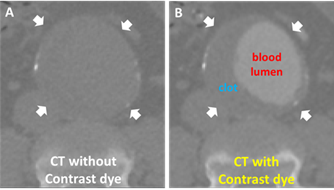The reason why contrast dyes are used with CT scans of the heart is to make it easier to visualise the blood flowing through the blood vessel and to identify where there might be a blood clot. Contrast dyes help distinguish or "contrast" selected areas of the body from surrounding tissue. As with any medical procedure or intervention there is always a slight risk, and with the iodine based dyes used for CT scans there is a small risk of complications such as kidney damage or allergic reaction. So, if there is a way to avoid the need for a contrast dye injection, this would be preferred.
The use of artificial intelligence and machine learning is improving heart diagnostics in a number of areas including the better accuracy of blood tests. The extension of AI into heart imaging too is therefore appropriate.
Contrast enhanced CT scans
 Heart Research UK have awarded a grant to Professor Regent Lee and his team at the University of Oxford. They have developed a computational method which uses artificial intelligence (AI) to generate ‘contrast enhanced’ CT scans without the need for using contrast dye.
Heart Research UK have awarded a grant to Professor Regent Lee and his team at the University of Oxford. They have developed a computational method which uses artificial intelligence (AI) to generate ‘contrast enhanced’ CT scans without the need for using contrast dye.
Blood clots (see pic opposite) can often be found inside arteries or veins, and the position and shape of the clot, in relation to the blood vessel wall, is important for the planning of treatment, such as the placement of a stent.
On routine CT scans, the human eye cannot detect the presence of abnormalities such as blood clots inside the blood vessel. Therefore, a special dye called a contrast agent, is injected into the patient to generate ‘contrast enhanced’ CT scans. This makes it easier to visualise the blood flowing through the blood vessel and to identify the blood clot.
Some patients should not be given contrast dye
There are several problems with the use of contrast dye. Contrast enhanced CT scans take longer to complete and require more radiation exposure for the patient. Patients usually get some mild reactions to the contrast dye and may be allergic to it, in which case they cannot have contrast enhanced CT scans.
Importantly, the use of contrast dye requires an intravenous injection into the patient’s arm. This can be both uncomfortable and can result in extravasation, when the dye may leak out from the injection site to the tissues under the skin causing skin problems. Contrast dye can sometimes damage the kidneys, which can be particularly problematic with elderly patients whose kidneys are not working at full capacity.
Reducing the use of contrast dye could have a positive impact on the environment and sustainability of healthcare. Radioactive contrast agents are a major component of pharmaceutical waste in hospital water systems. They are biologically inert and can linger in the wastewater system for a long time. Although the long-term impact on health is yet to be defined, several European countries are actively seeking solutions to minimise wastewater contamination by radioactive contrast agents.
Professor Lee’s team has developed a technology to generate contrast enhanced CT scans without the need to inject contrast dye. This research uses Al which is an advanced computing technology whereby a computer is programmed to mimic the learning and problem-solving abilities of the human mind. The grant from Heart Research UK will support the team to further develop their technology.
Although human eyes cannot tell the difference between blood flow and clot within the blood vessel on a routine CT scan, there are minute details in the scan that can be used to differentiate them.
Professor Lee says “The use of artificial intelligence in generating CT scans without the need for contrast dyes would allow diagnosis and treatment of blood vessel conditions with a reduced risk of complications. Furthermore, the reduced scanning time, radiation dose and lower cost would bring important benefits, not limited to the scanning of blood vessels. This method may be used for diagnosis and treatment planning for other medical conditions where contrast enhanced CT scans are required.”Kate Bratt-Farrar, Chief Executive of Heart Research UK, (pictured) said: “We are delighted that the grant will be supporting the work of Professor Lee and his team at the University of Oxford, whose ground-breaking work with AI may help to ultimately make the CT scanning of blood vessels safer, without the need for contrast dyes."
Kate goes onto say, “Heart Research UK’s Novel and Emerging Technologies research grants are all about helping patients. We are confident that Professor Lee’s pioneering project will not only utilise the latest and most innovative developments but also benefit those who need them, as soon as possible.”









